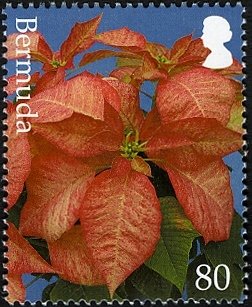Stamp: Bract colour: Mottled (Bermuda 2003)
Bract colour: Mottled (Bermuda 2003)
09 October (Bermuda ) within release Poinsettias goes into circulation Stamp Bract colour: Mottled face value 80 Bermudian cent
| Stamp Bract colour: Mottled in catalogues | |
|---|---|
| Stamp Number: | Sn:BM 873 |
Stamp is square format.
Watermark 373Also in the issue Poinsettias:
- Stamp - Bract colour: Red face value 30;
- Stamp - Bract colour: White face value 45;
- Stamp - Bract colour: Mottled face value 80;
|
Data entry completed
53%
|
|
|---|---|
| Stamp Bract colour: Mottled in digits | |
| Country: | Bermuda |
| Date: | 2003-10-09 |
| Perforation: | 14½ x 14¼ |
| Emission: | Commemorative |
| Format: | Stamp |
| Face Value: | 80 Bermudian cent |
Stamp Bract colour: Mottled it reflects the thematic directions:
A flower, sometimes known as a bloom or blossom, is the reproductive structure found in plants that are floral (plants of the division Magnoliophyta, also called angiosperms). The biological function of a flower is to effect reproduction, usually by providing a mechanism for the union of sperm with eggs. Flowers may facilitate outcrossing (fusion of sperm and eggs from different individuals in a population) or allow selfing (fusion of sperm and egg from the same flower). Some flowers produce diaspores without fertilization (parthenocarpy). Flowers contain sporangia and are the site where gametophytes develop. Many flowers have evolved to be attractive to animals, so as to cause them to be vectors for the transfer of pollen. After fertilization, the ovary of the flower develops into fruit containing seeds. In addition to facilitating the reproduction of flowering plants, flowers have long been admired and used by humans to beautify their environment, and also as objects of romance, ritual, religion, medicine and as a source of food.

